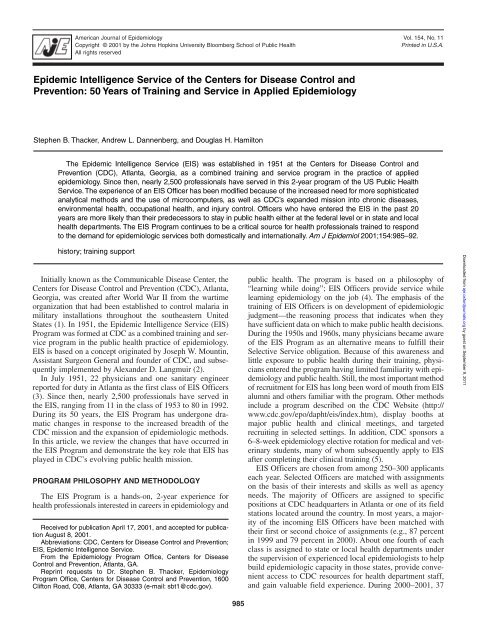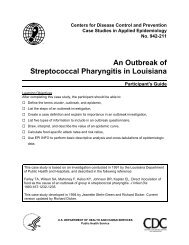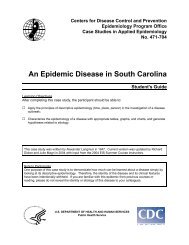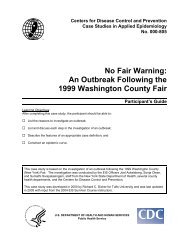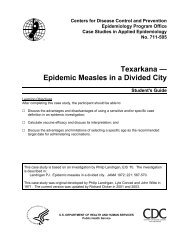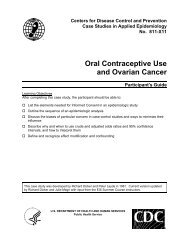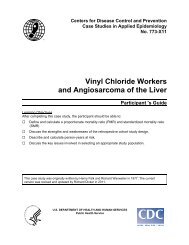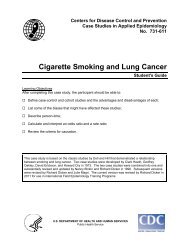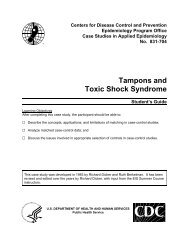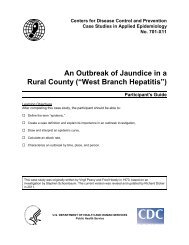Epidemic Intelligence Service of the Centers for Disease ... - Library
Epidemic Intelligence Service of the Centers for Disease ... - Library
Epidemic Intelligence Service of the Centers for Disease ... - Library
You also want an ePaper? Increase the reach of your titles
YUMPU automatically turns print PDFs into web optimized ePapers that Google loves.
American Journal <strong>of</strong> EpidemiologyCopyright © 2001 by <strong>the</strong> Johns Hopkins University Bloomberg School <strong>of</strong> Public HealthAll rights reservedVol. 154, No. 11Printed in U.S.A.EIS: Training and <strong>Service</strong> in Applied Epidemiology Thacker et al.<strong>Epidemic</strong> <strong>Intelligence</strong> <strong>Service</strong> <strong>of</strong> <strong>the</strong> <strong>Centers</strong> <strong>for</strong> <strong>Disease</strong> Control andPrevention: 50 Years <strong>of</strong> Training and <strong>Service</strong> in Applied EpidemiologyStephen B. Thacker, Andrew L. Dannenberg, and Douglas H. HamiltonThe <strong>Epidemic</strong> <strong>Intelligence</strong> <strong>Service</strong> (EIS) was established in 1951 at <strong>the</strong> <strong>Centers</strong> <strong>for</strong> <strong>Disease</strong> Control andPrevention (CDC), Atlanta, Georgia, as a combined training and service program in <strong>the</strong> practice <strong>of</strong> appliedepidemiology. Since <strong>the</strong>n, nearly 2,500 pr<strong>of</strong>essionals have served in this 2-year program <strong>of</strong> <strong>the</strong> US Public Health<strong>Service</strong>. The experience <strong>of</strong> an EIS Officer has been modified because <strong>of</strong> <strong>the</strong> increased need <strong>for</strong> more sophisticatedanalytical methods and <strong>the</strong> use <strong>of</strong> microcomputers, as well as CDC’s expanded mission into chronic diseases,environmental health, occupational health, and injury control. Officers who have entered <strong>the</strong> EIS in <strong>the</strong> past 20years are more likely than <strong>the</strong>ir predecessors to stay in public health ei<strong>the</strong>r at <strong>the</strong> federal level or in state and localhealth departments. The EIS Program continues to be a critical source <strong>for</strong> health pr<strong>of</strong>essionals trained to respondto <strong>the</strong> demand <strong>for</strong> epidemiologic services both domestically and internationally. Am J Epidemiol 2001;154:985–92.history; training supportInitially known as <strong>the</strong> Communicable <strong>Disease</strong> Center, <strong>the</strong><strong>Centers</strong> <strong>for</strong> <strong>Disease</strong> Control and Prevention (CDC), Atlanta,Georgia, was created after World War II from <strong>the</strong> wartimeorganization that had been established to control malaria inmilitary installations throughout <strong>the</strong> sou<strong>the</strong>astern UnitedStates (1). In 1951, <strong>the</strong> <strong>Epidemic</strong> <strong>Intelligence</strong> <strong>Service</strong> (EIS)Program was <strong>for</strong>med at CDC as a combined training and serviceprogram in <strong>the</strong> public health practice <strong>of</strong> epidemiology.EIS is based on a concept originated by Joseph W. Mountin,Assistant Surgeon General and founder <strong>of</strong> CDC, and subsequentlyimplemented by Alexander D. Langmuir (2).In July 1951, 22 physicians and one sanitary engineerreported <strong>for</strong> duty in Atlanta as <strong>the</strong> first class <strong>of</strong> EIS Officers(3). Since <strong>the</strong>n, nearly 2,500 pr<strong>of</strong>essionals have served in<strong>the</strong> EIS, ranging from 11 in <strong>the</strong> class <strong>of</strong> 1953 to 80 in 1992.During its 50 years, <strong>the</strong> EIS Program has undergone dramaticchanges in response to <strong>the</strong> increased breadth <strong>of</strong> <strong>the</strong>CDC mission and <strong>the</strong> expansion <strong>of</strong> epidemiologic methods.In this article, we review <strong>the</strong> changes that have occurred in<strong>the</strong> EIS Program and demonstrate <strong>the</strong> key role that EIS hasplayed in CDC’s evolving public health mission.PROGRAM PHILOSOPHY AND METHODOLOGYThe EIS Program is a hands-on, 2-year experience <strong>for</strong>health pr<strong>of</strong>essionals interested in careers in epidemiology andReceived <strong>for</strong> publication April 17, 2001, and accepted <strong>for</strong> publicationAugust 8, 2001.Abbreviations: CDC, <strong>Centers</strong> <strong>for</strong> <strong>Disease</strong> Control and Prevention;EIS, <strong>Epidemic</strong> <strong>Intelligence</strong> <strong>Service</strong>.From <strong>the</strong> Epidemiology Program Office, <strong>Centers</strong> <strong>for</strong> <strong>Disease</strong>Control and Prevention, Atlanta, GA.Reprint requests to Dr. Stephen B. Thacker, EpidemiologyProgram Office, <strong>Centers</strong> <strong>for</strong> <strong>Disease</strong> Control and Prevention, 1600Clifton Road, C08, Atlanta, GA 30333 (e-mail: sbt1@cdc.gov).public health. The program is based on a philosophy <strong>of</strong>“learning while doing”; EIS Officers provide service whilelearning epidemiology on <strong>the</strong> job (4). The emphasis <strong>of</strong> <strong>the</strong>training <strong>of</strong> EIS Officers is on development <strong>of</strong> epidemiologicjudgment—<strong>the</strong> reasoning process that indicates when <strong>the</strong>yhave sufficient data on which to make public health decisions.During <strong>the</strong> 1950s and 1960s, many physicians became aware<strong>of</strong> <strong>the</strong> EIS Program as an alternative means to fulfill <strong>the</strong>irSelective <strong>Service</strong> obligation. Because <strong>of</strong> this awareness andlittle exposure to public health during <strong>the</strong>ir training, physiciansentered <strong>the</strong> program having limited familiarity with epidemiologyand public health. Still, <strong>the</strong> most important method<strong>of</strong> recruitment <strong>for</strong> EIS has long been word <strong>of</strong> mouth from EISalumni and o<strong>the</strong>rs familiar with <strong>the</strong> program. O<strong>the</strong>r methodsinclude a program described on <strong>the</strong> CDC Website (http://www.cdc.gov/epo/dapht/eis/index.htm), display booths atmajor public health and clinical meetings, and targetedrecruiting in selected settings. In addition, CDC sponsors a6–8-week epidemiology elective rotation <strong>for</strong> medical and veterinarystudents, many <strong>of</strong> whom subsequently apply to EISafter completing <strong>the</strong>ir clinical training (5).EIS Officers are chosen from among 250–300 applicantseach year. Selected Officers are matched with assignmentson <strong>the</strong> basis <strong>of</strong> <strong>the</strong>ir interests and skills as well as agencyneeds. The majority <strong>of</strong> Officers are assigned to specificpositions at CDC headquarters in Atlanta or one <strong>of</strong> its fieldstations located around <strong>the</strong> country. In most years, a majority<strong>of</strong> <strong>the</strong> incoming EIS Officers have been matched with<strong>the</strong>ir first or second choice <strong>of</strong> assignments (e.g., 87 percentin 1999 and 79 percent in 2000). About one fourth <strong>of</strong> eachclass is assigned to state or local health departments under<strong>the</strong> supervision <strong>of</strong> experienced local epidemiologists to helpbuild epidemiologic capacity in those states, provide convenientaccess to CDC resources <strong>for</strong> health department staff,and gain valuable field experience. During 2000–2001, 37Downloaded from aje.ox<strong>for</strong>djournals.org by guest on September 9, 2011985
986 Thacker et al.EIS Officers were assigned to state and local health departmentsin 25 states and to <strong>the</strong> Indian Health <strong>Service</strong> in NewMexico. Each EIS assignment is reviewed regularly toensure <strong>the</strong> best possible experience <strong>for</strong> <strong>the</strong> Officers.THE EIS CURRICULUMFor each cohort <strong>of</strong> EIS Officers, training begins with a 3-week course that features up to 10 interactive case studies,didactic sessions in applied epidemiology and biostatistics,and a field exercise. Most <strong>of</strong> <strong>the</strong>se cases are based on epidemiologicinvestigations conducted by EIS Officers (6);some are available to <strong>the</strong> public health community <strong>for</strong> teachingpurposes at <strong>the</strong> following CDC Website: http://www.cdc.gov/epo/dapht/eis/case.htm. In 2000, <strong>the</strong> field exerciseincluded observational surveys <strong>of</strong> <strong>the</strong> implementation <strong>of</strong>restaurant smoking restriction laws in two Georgia counties.The success <strong>of</strong> <strong>the</strong> EIS course has been reflected by its adaptation<strong>for</strong> state and local health department pr<strong>of</strong>essionalsenrolled in <strong>the</strong> 2-week Epidemiology in Action course aswell as in <strong>the</strong> development <strong>of</strong> <strong>the</strong> 4-week InternationalCourse in Applied Epidemiology. Both courses are conductedby <strong>the</strong> Emory University Rollins School <strong>of</strong> PublicHealth (Atlanta) in collaboration with CDC. In addition, <strong>the</strong>US Department <strong>of</strong> Agriculture, <strong>the</strong> Quebec Center <strong>for</strong>Epidemiologic Investigations (Canada), <strong>the</strong> MerieuxFoundation (Lyon, France), <strong>the</strong> National School <strong>of</strong> PublicHealth in France, and more than 20 applied epidemiologytraining programs internationally have sponsored similarcourses with <strong>the</strong> assistance <strong>of</strong> CDC.The 3-week course is only <strong>the</strong> beginning <strong>of</strong> an EISOfficer’s training in applied epidemiology. The practical, inservicetraining in epidemiology is primarily a function <strong>of</strong><strong>the</strong> 2-year assignment, where <strong>the</strong> EIS Officers learn <strong>the</strong>basic skills <strong>of</strong> epidemiology under <strong>the</strong> supervision <strong>of</strong> anexperienced mentor. The Officers conduct epidemiologicinvestigations and research ei<strong>the</strong>r in a specific program area,such as chronic or infectious diseases if assigned to CDC, orduring state or local health department assignments, whichusually provide <strong>the</strong> broadest spectrum <strong>of</strong> experience in <strong>the</strong>public health practice <strong>of</strong> epidemiology.In <strong>the</strong> fall <strong>of</strong> <strong>the</strong> first year, all EIS Officers participate ina 1-week course focusing on public health surveillancemethods and more advanced epidemiologic techniques. Aspart <strong>of</strong> <strong>the</strong> course, each Officer evaluates an existing publichealth surveillance system by using a published evaluationframework (7). Not infrequently, <strong>the</strong> Officer’s evaluationsubsequently is used to improve that surveillance system. In1994, <strong>the</strong> EIS Program introduced scientific writing and preventioneffectiveness methods (economic tools <strong>for</strong> publichealth) to <strong>the</strong> EIS curriculum as a 1-week course <strong>for</strong> secondyearOfficers (8, 9). In December <strong>of</strong> that first year, eachOfficer is expected to submit an abstract <strong>of</strong> a completedstudy <strong>for</strong> presentation at <strong>the</strong> annual EIS Conference held atCDC in April. In 2000, over 1,300 persons attended thisconference, which included 120 oral and poster presentations.Throughout <strong>the</strong> year, <strong>the</strong> Officers present <strong>the</strong> results <strong>of</strong><strong>the</strong>ir investigations at a weekly seminar series.In <strong>the</strong> early spring, EIS Officers meet with CDC staff toreview <strong>the</strong>ir experience. From <strong>the</strong>se meetings <strong>of</strong> groups <strong>of</strong>8–10 Officers, <strong>the</strong> staff is able to modify <strong>the</strong> experience toimprove <strong>the</strong> educational opportunity as well as <strong>the</strong> service<strong>the</strong> Officer provides.During <strong>the</strong> 2 years <strong>of</strong> training, each Officer is expected t<strong>of</strong>ulfill a minimum set <strong>of</strong> specific Core Activities <strong>for</strong>Learning (table 1), including conduct <strong>of</strong> field investigations,analysis <strong>of</strong> large databases, practice <strong>of</strong> public health surveillance,scientific writing, effective oral communication, andTABLE 1. Core Activities <strong>for</strong> Learning, <strong>Epidemic</strong> <strong>Intelligence</strong> <strong>Service</strong>, <strong>Centers</strong> <strong>for</strong> <strong>Disease</strong> Control andPrevention, Atlanta, GeorgiaDownloaded from aje.ox<strong>for</strong>djournals.org by guest on September 9, 2011The <strong>Epidemic</strong> <strong>Intelligence</strong> <strong>Service</strong> (EIS) Officer will per<strong>for</strong>m <strong>the</strong> following activities:CAL* 1. Conduct or participate substantively in a field investigation <strong>of</strong> a potentially serious public healthproblem that requires a rapid public health response.CAL 2. Design, conduct, and interpret an epidemiologic analysis on a new or preexisting database thathas a sample size that permits assessment <strong>of</strong> confounding and effect modification. As a result <strong>of</strong><strong>the</strong> analysis, appropriate public health recommendations should be made.CAL 3. Design, implement, or evaluate a public health surveillance system and deliver a written and/orverbal report on this system as required during <strong>the</strong> fall EIS course.CAL 4. Write (as first author) a scientific manuscript <strong>for</strong> submission to a peer-reviewed journal.CAL 5. Write and submit a report to <strong>the</strong> Morbidity and Mortality Weekly Report (MMWR).CAL 6. Participate in <strong>the</strong> EIS Conference by giving an oral presentation or a poster presentation.CAL 7. Give an oral presentation at <strong>the</strong> Tuesday Morning Epidemiology Seminar at <strong>the</strong> <strong>Centers</strong><strong>for</strong> <strong>Disease</strong> Control and Prevention or at a national scientific meeting with a substantialepidemiologic constituency (such as <strong>the</strong> Society <strong>for</strong> Epidemiologic Research or <strong>the</strong> AmericanPublic Health Association).CAL 8. Respond appropriately to written or oral public health inquiries from <strong>the</strong> public, <strong>the</strong> media,government <strong>of</strong>ficials, or o<strong>the</strong>r health pr<strong>of</strong>essionals.* CAL, Core Activity <strong>for</strong> Learning.Am J Epidemiol Vol. 154, No. 11, 2001
EIS: Training and <strong>Service</strong> in Applied Epidemiology 987responsiveness to <strong>the</strong> public. These core activities are usedas a guide <strong>for</strong> developing <strong>the</strong> requisite skills <strong>of</strong> a practicingepidemiologist.Since 1980, <strong>the</strong> content <strong>of</strong> <strong>the</strong> training <strong>of</strong> EIS Officers hasevolved. There has been an increasing emphasis on publichealth surveillance, noninfectious diseases, and moreadvanced analytical methods, such as logistic regressionanalysis in case-control studies, application <strong>of</strong> time-seriesanalysismethods to surveillance data, and use <strong>of</strong> geographicin<strong>for</strong>mation systems. Since <strong>the</strong> 1980s, EIS Officers havebeen trained to use computers in <strong>the</strong>ir daily work; laptopcomputers are now routinely carried on all field investigations.In more recent years, <strong>the</strong> Internet has become anintegral part <strong>of</strong> <strong>the</strong> EIS experience, not only <strong>for</strong> rapid communicationand distance-based training but also to transmitand analyze essential public health data. EPI INFO, a computers<strong>of</strong>tware package, was developed by CDC <strong>for</strong> use byEIS Officers and o<strong>the</strong>r epidemiologists <strong>for</strong> questionnairedevelopment, word processing, data entry, statistical analysis,development <strong>of</strong> tables and figures, and manuscriptpreparation (10). EIS Officers also use EPI INFO to disseminatesurveillance data between state and local healthdepartments and CDC, and as a tool <strong>for</strong> analysis <strong>of</strong> surveillancedata.EPIDEMIOLOGIC FIELD INVESTIGATIONSAND SERVICE CONTRIBUTIONSSince <strong>the</strong> EIS Program began, EIS Officers have participatedin landmark epidemiologic investigations (table 2). At<strong>the</strong> request <strong>of</strong> state health departments, o<strong>the</strong>r countries, orinternational organizations, headquarters-based EIS Officershave taken part in more than 4,000 epidemiologic investigationsor Epi-Aids <strong>of</strong> national and international importancesince 1951 (11). Officers assigned to state and local healthdepartments conduct an additional 400 investigations eachyear.Forty-three years after an EIS investigation <strong>of</strong> vaccineassociatedpolio cases helped to rescue <strong>the</strong> first nationalpolio vaccine program (12), EIS Officers played a criticalrole in identifying ano<strong>the</strong>r vaccine-related epidemic (13).On August 31, 1998, <strong>the</strong> first rotavirus vaccine waslicensed in <strong>the</strong> United States <strong>for</strong> use in infants. Rotavirus,<strong>the</strong> most common cause <strong>of</strong> infectious diarrhea in smallchildren in this country, causes 20–40 deaths and morethan 50,000 hospitalizations annually. After receivingreports <strong>of</strong> intussusception among infants who had beenvaccinated, CDC recommended suspending use <strong>of</strong> <strong>the</strong>vaccine on July 16, 1999, and immediately launched anationwide study to examine <strong>the</strong> association betweenrotavirus vaccine and intussusception. EIS Officersassigned to state health departments were mobilized in 12states that had received large quantities <strong>of</strong> <strong>the</strong> vaccine, andOfficers from Atlanta were sent to three o<strong>the</strong>r states. TheseEIS Officers obtained crucial in<strong>for</strong>mation by interviewingparents and physicians <strong>of</strong> affected infants, and <strong>the</strong>yreviewed medical and vaccination records. For comparison,<strong>the</strong>y ga<strong>the</strong>red similar in<strong>for</strong>mation on a group <strong>of</strong>healthy infants, matched by age and hospital. The investi-Am J Epidemiol Vol. 154, No. 11, 2001TABLE 2. Selected investigations in which <strong>Epidemic</strong><strong>Intelligence</strong> <strong>Service</strong> Officers have participated, UnitedStates, 1951–20001951–1960• Contamination <strong>of</strong> killed poliovirus vaccine with live virus• Asian influenza epidemics• Nosocomial staphylococcal epidemics• Childhood lead poisoning from peeling paint1961–1970• Cases <strong>of</strong> poliomyelitis associated with oral vaccine• Smallpox epidemics through 1977• Hong Kong influenza epidemics• Hurricane Camille aftereffects• Salmonellosis in commercial chicken1971–1980• Salmonella in pet turtles• Oyster-associated hepatitis• Bacteremia from contaminated intravenous fluids• Childhood lead poisoning from environmental exposure• Norwalk virus epidemic• Vinyl-chloride-associated liver cancer• Legionnaires’ disease• Ebola virus in Zaire and <strong>the</strong> Sudan• Guillain-Barré syndrome associated with swine influenza vaccine• Toxic shock syndrome• Heat-wave-associated morbidity and mortality in Missouri• Aspirin-associated Reye’s syndrome• National study <strong>of</strong> <strong>the</strong> efficacy <strong>of</strong> nosocomial infection control(SENIC)• National cancer and steroid hormone study• Investigation <strong>of</strong> <strong>the</strong> health effects <strong>of</strong> <strong>the</strong> Three Mile Island nuclearincident (Pennsylvania)1981–1990• Health effects <strong>of</strong> <strong>the</strong> Mount St. Helens volcano eruption(Washington State)• Acquired immunodeficiency syndrome• Accutane-associated birth defects• Escherichia coli O:157:H7 associated with hemorrhagic diarrheaand hemolytic uremic syndrome• Role <strong>of</strong> parvovirus in ery<strong>the</strong>ma infectiosum (fifth disease)• Toxic oil syndrome in Spain• Eosinophilia-myalgia syndrome• Clusters <strong>of</strong> suicides by teenagers• Vietnam veterans studies• Mercury poisoning from commercial paint1991–2000• Multistate outbreak <strong>of</strong> E. coli O157:H7- associated diarrhea andhemolytic uremic syndrome from hamburgers• Hantavirus pulmonary syndrome• Health effects <strong>of</strong> Hurricane Andrew• Cryptosporidiosis from contaminated public drinking water inMilwaukee (Wisconsin)• Acute renal failure in Haiti from acetaminophen contaminated withdiethylene glycol• Impact <strong>of</strong> physician-assisted suicide in Oregon• Multistate outbreak <strong>of</strong> salmonella associated with commercial icecream• Suicide after natural disasters• Rotavirus vaccine recall• West Nile virus epidemic• Cardiac valvulopathy associated with fenfluramine (fen-phen)• Violence against mo<strong>the</strong>rs <strong>of</strong> newborns <strong>of</strong> unintended pregnancies• Definition <strong>of</strong> excessive weight gain in pregnancyDownloaded from aje.ox<strong>for</strong>djournals.org by guest on September 9, 2011
988 Thacker et al.gation confirmed that intussusception occurred with significantlyincreased frequency in <strong>the</strong> first 1–2 weeks aftervaccination with <strong>the</strong> rotavirus vaccine, particularly after<strong>the</strong> first dose.On <strong>the</strong> basis <strong>of</strong> this investigation, <strong>the</strong> AdvisoryCommittee on Immunization Practices withdrew its recommendation<strong>for</strong> use <strong>of</strong> <strong>the</strong> vaccine on October 22, 1999, and<strong>the</strong> manufacturer removed <strong>the</strong> product from <strong>the</strong> market. Theresults <strong>of</strong> <strong>the</strong> investigation changed national vaccine policyand protected infants from a potentially fatal complication<strong>of</strong> a new vaccine. Having a cadre <strong>of</strong> EIS Officers ready torespond immediately and to focus intensely on this problemmade CDC’s timely response possible.PROFILE OF THE EIS OFFICERThe pr<strong>of</strong>ile <strong>of</strong> <strong>the</strong> EIS Officer has changed in <strong>the</strong> pasttwo decades. Be<strong>for</strong>e 1980, 430 <strong>of</strong> <strong>the</strong> 461 EIS Officers (93percent) were physicians, and 416 (90 percent) were male(14). Only one epidemiologist with a nonmedical doctoraldegree had served in EIS be<strong>for</strong>e 1980, and <strong>the</strong> first non-UScitizen entered <strong>the</strong> class in 1975. Through 2000, 221 nonmedicaldoctoral-level scientists had entered EIS, 122 (55percent) with an advanced degree in epidemiology and o<strong>the</strong>rswith degrees in demography, anthropology, behavioraland social sciences, statistics, and o<strong>the</strong>r health areas (15)(table 3). From 1975 through 1998, 174 non-US citizensfrom 62 countries had enrolled in EIS (16). About half <strong>of</strong><strong>the</strong> physicians entering recent classes have completedmasters-level training in public health; be<strong>for</strong>e 1980, fewphysicians came to EIS with this background. Ano<strong>the</strong>rimportant change in <strong>the</strong> pr<strong>of</strong>ile <strong>of</strong> <strong>the</strong> EIS class has been <strong>the</strong>increasing number <strong>of</strong> racial/ethnic minorities in each class,growing from an average <strong>of</strong> less than 1 percent per class in<strong>the</strong> first two decades <strong>of</strong> <strong>the</strong> program to approximately 25percent in recent EIS classes. The 73 Officers in <strong>the</strong> class <strong>of</strong>2000 include 44 women, 17 US minorities, 13 non-US citizens,50 physicians, 22 nonmedical doctoral-level scientists,and 1 dentist.IMPACT OF EIS ON PUBLIC HEALTH PRACTICEThe graduates <strong>of</strong> <strong>the</strong> EIS Program have made a majorimpact on <strong>the</strong> health <strong>of</strong> <strong>the</strong> nation and <strong>the</strong> world as a result<strong>of</strong> <strong>the</strong>ir subsequent career choices. During <strong>the</strong> first 25 years<strong>of</strong> <strong>the</strong> program, approximately 35 percent <strong>of</strong> graduatesstayed in public health, approximately 33 percent returnedto academic careers, and 25 percent went into private practice.Today, because <strong>of</strong> increasing interest in epidemiologyand public health among applicants (and no Selective<strong>Service</strong> influence), nearly 90 percent <strong>of</strong> EIS graduatesembark on public health careers at <strong>the</strong> local, state, federal,or international level.The health agencies <strong>of</strong> <strong>the</strong> federal government, especiallyCDC, are <strong>the</strong> most frequent employers <strong>of</strong> EIS graduates(table 4). Compared with EIS graduates from <strong>the</strong> 1960s,1990s graduates were more likely to be employed by CDC(52 percent vs. 2 percent), a state or local health department(11 percent vs. 3 percent), or an international health agency(7 percent vs. 1 percent) (table 5). These more recent graduateswere less likely than those from <strong>the</strong> 1950s and 1960sto be employed on a university faculty (9 percent vs. 24 percent)or to work in private practice or in business (5 percentvs. 42 percent).When we examine cohorts <strong>of</strong> Officers over time (namely,<strong>the</strong> classes <strong>of</strong> 1955, 1965, 1975, 1985, and 1995), we findTABLE 3. Numbers <strong>of</strong> <strong>Epidemic</strong> <strong>Intelligence</strong> <strong>Service</strong> Officers, by pr<strong>of</strong>essional category and period <strong>of</strong>entry into <strong>the</strong> program, <strong>Centers</strong> <strong>for</strong> <strong>Disease</strong> Control and Prevention, Atlanta, Georgia, 1951–2000Downloaded from aje.ox<strong>for</strong>djournals.org by guest on September 9, 2011Pr<strong>of</strong>essional category1951–1960150330215711961–1970Period <strong>of</strong> entry (years)1971–19801981–19901991–2000TotalPhysicianVeterinarianEpidemiology/Public HealthStatistician, DemographerNurseBiologist/MicrobiologistAnthropologist, SociologistSanitary Engineer,Industrial HygienistO<strong>the</strong>r doctoral degreesDentistPublic health advisor,Health <strong>Service</strong>s OfficerChemist/Biochemist/ToxicologistPharmacistSubtotalHonoraryTotal2010003843602216010110043013325110023015053647613054320214757172316010056110421,9441891225440141775917464220045214612624372012,47772204534636277212,484Am J Epidemiol Vol. 154, No. 11, 2001
EIS: Training and <strong>Service</strong> in Applied Epidemiology 989TABLE 4. Current employment positions <strong>of</strong> 1951–1998 alumni <strong>of</strong> <strong>the</strong> <strong>Epidemic</strong> <strong>Intelligence</strong> <strong>Service</strong>, bytype <strong>of</strong> employer and pr<strong>of</strong>essional category on entry to <strong>the</strong> programLocation or typeFederal government<strong>Centers</strong> <strong>for</strong> <strong>Disease</strong> Control andPreventionO<strong>the</strong>r US Department <strong>of</strong> Health andHuman <strong>Service</strong>sO<strong>the</strong>r federal governmentState and local health departmentsInternational agency/governmentO<strong>the</strong>r health agencyUniversity facultyMedical schoolO<strong>the</strong>r universityResidency, fellowship, o<strong>the</strong>r graduatestudyPrivate practice, businessO<strong>the</strong>rRetiredDeceasedTotalPhysician58349174181479866331189142144649572501,920o<strong>the</strong>r trends (table 6). For example, during <strong>the</strong> earlydecades, when training was sometimes interrupted bySelective <strong>Service</strong> pressures, about half <strong>of</strong> <strong>the</strong> graduatesreturned <strong>for</strong> additional academic clinical training, whereas,in subsequent years, fewer Officers sought academic trainingimmediately after completing <strong>the</strong> EIS Program, andmany <strong>of</strong> <strong>the</strong>m entered <strong>the</strong> CDC Preventive MedicineResidency Program, a public health ra<strong>the</strong>r than clinicalPr<strong>of</strong>essional categoryVeterinarian6841111626451521302282311182O<strong>the</strong>r947912321016391227126182010236Total74561197371751128738520318215512121115712,338training program established in 1972. The class <strong>of</strong> 1995included 75 Officers; 13 (17 percent) sought fur<strong>the</strong>r trainingafter finishing EIS, 12 were in <strong>the</strong> CDC PreventiveMedicine Residency, and only 1 entered a clinical residency.Looking at <strong>the</strong>se same five cohorts, we found that whileCDC retained large numbers <strong>of</strong> Officers in each cohort(33–48 percent), <strong>the</strong> number <strong>of</strong> those choosing academiccareers or private practice dropped dramatically over <strong>the</strong>TABLE 5. Current employment positions <strong>of</strong> 1951–1998 alumni <strong>of</strong> <strong>the</strong> <strong>Epidemic</strong> <strong>Intelligence</strong> <strong>Service</strong>, by type <strong>of</strong> employer anddecade <strong>of</strong> entry in <strong>the</strong> program%31.926.14.11.67.54.83.716.58.77.80.621.95.24.93.0100.0Downloaded from aje.ox<strong>for</strong>djournals.org by guest on September 9, 2011Location or typeFederal government<strong>Centers</strong> <strong>for</strong> <strong>Disease</strong> Control andPreventionO<strong>the</strong>r US Department <strong>of</strong> Healthand Human <strong>Service</strong>sO<strong>the</strong>r federal governmentState and local health departmentsInternational agency/governmentO<strong>the</strong>r health agencyUniversity facultyMedical schoolO<strong>the</strong>r universityResidency, fellowship, o<strong>the</strong>r graduatestudyPrivate practice, businessO<strong>the</strong>rRetiredDeceasedTotalDecade <strong>of</strong> entryAll decades1950s1960s1970s1980s1990s(1951–1998)No. % No. % No. % No. % No. % No. %5 2.5 20 4.7 85 18.4 267 43.0 368 57.8 745 31.91312144220220261868311970.51.50.51.00.52.021.310.211.20.013.29.134.515.7100.088414421101633801772639214231.91.90.93.30.95.023.914.99.00.041.86.19.25.0100.06616325152393474601782541446214.33.50.65.43.25.020.110.210.00.038.55.40.93.0100.02074218614819944648198234461933.36.82.99.87.73.115.17.47.70.215.83.70.60.6100.032928117344205527281433290163751.64.41.711.56.93.18.64.24.42.25.24.60.00.2100.061197371751128738520318215512121115712,33826.14.11.67.54.83.716.58.77.80.621.95.24.93.0100.0Am J Epidemiol Vol. 154, No. 11, 2001
990 Thacker et al.TABLE 6. Selected characteristics regarding <strong>the</strong> pr<strong>of</strong>essional experience <strong>of</strong> five cohorts <strong>of</strong> <strong>Epidemic</strong> <strong>Intelligence</strong> <strong>Service</strong> Officersfollowing completion <strong>of</strong> <strong>the</strong> programClass year(no. <strong>of</strong> Officers)ClinicalresidencyCDCPreventiveMedicineResidency*CDCO<strong>the</strong>r publichealthInitial employmentAcademicPrivate practiceCareerpublic heal<strong>the</strong>mploymentNo.% No. % No. % No. % No. % No. % No. %1955 (36)1965 (31)1975 (49)1985 (67)1995 (75)1821233150684741718121427161211203231* The <strong>Centers</strong> <strong>for</strong> <strong>Disease</strong> Control and Prevention (CDC) Preventive Medicine Residency was established in 1972.33354148413762435823123647101016852832331271137343110144520163059665652618888years. O<strong>the</strong>r federal agencies as well as state and localhealth departments retained <strong>the</strong> services <strong>of</strong> EIS graduates inincreasing numbers during <strong>the</strong> past two decades. While amajority <strong>of</strong> graduates <strong>of</strong> all EIS classes spent at least part <strong>of</strong><strong>the</strong>ir careers in public health practice, nearly 9 <strong>of</strong> 10Officers in recent years have made public health practice acareer choice. Looking at <strong>the</strong> 75 graduates <strong>of</strong> <strong>the</strong> class <strong>of</strong>1995, 31 (41 percent) found <strong>the</strong>ir first jobs at CDC, 6 (8 percent)found jobs at o<strong>the</strong>r federal agencies, 21 (28 percent)immediately found jobs in state or local health departments,8 (11 percent) worked <strong>for</strong> international agencies, 5 (7 percent)joined university faculties, and 4 (5 percent) enteredprivate medical practice.Ano<strong>the</strong>r measure <strong>of</strong> <strong>the</strong> impact <strong>of</strong> EIS is <strong>the</strong> number <strong>of</strong>EIS alumni currently holding positions <strong>of</strong> leadership in publichealth. In 2000, 43 percent <strong>of</strong> state and territorial epidemiologistswere EIS graduates (http://www.cste.org). Thecurrent CDC Director (and two previous Directors) and aDeputy Director are graduates <strong>of</strong> <strong>the</strong> program, as are <strong>the</strong>directors <strong>of</strong> 9 <strong>of</strong> <strong>the</strong> 11 major CDC organizational units andmuch <strong>of</strong> <strong>the</strong> CDC leadership throughout <strong>the</strong> organization.Currently, EIS alumni are serving as deans <strong>of</strong> 10 schools <strong>of</strong>public health; two EIS alumni have each served as dean <strong>of</strong>two schools <strong>of</strong> public health. Numerous o<strong>the</strong>r EIS alumnihave been departmental chairs in both schools <strong>of</strong> publichealth and schools <strong>of</strong> medicine. Two alumni have served asSurgeon General <strong>of</strong> <strong>the</strong> United States.Although difficult to quantify, <strong>the</strong> networking and camaraderieamong EIS graduates continues to streng<strong>the</strong>n <strong>the</strong>overall public health infrastructure by facilitating in<strong>for</strong>mationexchange among alumni located in key public healthpositions throughout <strong>the</strong> nation and world. Publication <strong>of</strong> anannual alumni directory and a quarterly alumni bulletin, aswell as <strong>the</strong> annual EIS Conference each April, facilitatessuch networking.The EIS Program has had a major effect on o<strong>the</strong>r publichealth training programs. The Public Health Prevention<strong>Service</strong>, CDC’s new program to train masters-level pr<strong>of</strong>essionalsto design, implement, and evaluate public healthinterventions (http://www.cdc.gov/epo/dapht/phps.htm),was developed in part because <strong>of</strong> CDC’s long experience intraining EIS Officers.The international impact <strong>of</strong> EIS has been dramatic. In <strong>the</strong>past 3 years, 61 percent <strong>of</strong> EIS Officers have participated in atleast one international assignment ranging from an Ebolavirus investigation in Uganda to post-hurricane health needsassessment in Central America, an inquiry into war-relateddeaths in Kosovo, and a childhood lead poisoning investigationin Bangladesh. Since 1999, in collaboration with <strong>the</strong>World Health Organization, 49 EIS Officers have completed3-month assignments in Africa and south Asia as members <strong>of</strong>STOP (Stop Transmission <strong>of</strong> Polio) teams dedicated to <strong>the</strong>global eradication <strong>of</strong> polio. Short-term international assignmentscontribute to <strong>the</strong> pr<strong>of</strong>essional growth <strong>of</strong> EIS Officersand lead to <strong>the</strong> development <strong>of</strong> a cadre <strong>of</strong> experienced healthpr<strong>of</strong>essionals able to respond to public health emergenciesanywhere in <strong>the</strong> world. Today, 160 EIS graduates are workingoutside <strong>of</strong> <strong>the</strong> United States in 54 countries on six continents.Many EIS alumni are serving or have served in leadershiproles <strong>for</strong> <strong>the</strong> World Health Organization, <strong>the</strong> Pan AmericanHealth Organization, <strong>the</strong> World Bank, and o<strong>the</strong>r internationalorganizations and foundations.An important aspect <strong>of</strong> international training has been <strong>the</strong>role <strong>of</strong> EIS graduates in replicating <strong>the</strong> EIS training modelin more than 20 developed and developing countries around<strong>the</strong> world (17). A network <strong>of</strong> <strong>the</strong>se applied epidemiologytraining programs, known as TEPHINET, was created in1997 to facilitate interchange among <strong>the</strong>se programs (18).Nearly 900 epidemiologists have graduated from <strong>the</strong>se programsin <strong>the</strong> past two decades.DISCUSSIONThe first priority <strong>of</strong> <strong>the</strong> EIS Program is to train a highlymotivated group <strong>of</strong> capable health pr<strong>of</strong>essionals who areable to respond to future public health needs both domesticallyand internationally. From its initial group composedprimarily <strong>of</strong> White male physicians focused on infectiousdiseases, <strong>the</strong> EIS Program has evolved to better reflect <strong>the</strong>growing diversity <strong>of</strong> health pr<strong>of</strong>essionals and public healthproblems that are important in today’s society. The increasingnumber <strong>of</strong> women and racial/ethnic minority pr<strong>of</strong>essionalsin EIS results from active ef<strong>for</strong>ts by CDC to increasediversity in <strong>the</strong> public health work<strong>for</strong>ce. The increasedAm J Epidemiol Vol. 154, No. 11, 2001Downloaded from aje.ox<strong>for</strong>djournals.org by guest on September 9, 2011
EIS: Training and <strong>Service</strong> in Applied Epidemiology 991range <strong>of</strong> pr<strong>of</strong>essional backgrounds among EIS Officers—veterinarians, doctoral-level epidemiologists, social andbehavorial scientists, nurses, and dentists—reflects <strong>the</strong>agency’s need to be able to respond to public health problems<strong>of</strong> social, behavioral, environmental, occupational,genetic, and infectious etiologies. EIS recently expandedadmission eligibility to include physician assistants andpharmacists, as well as lawyers with prior public healthtraining and an interest in epidemiology.The EIS Program has been very successful, but <strong>the</strong>re havebeen many challenges over <strong>the</strong> years. First, because it isbased in a federal agency, <strong>the</strong> program is required to followgovernment rules and guidelines. Compliance with <strong>the</strong> procedures<strong>of</strong> <strong>the</strong> civil service and <strong>the</strong> Commissioned Corpsresults in salary differentials among Officers, a problem thatbecame more visible as increasing numbers <strong>of</strong> nonphysiciansand non-US citizens entered <strong>the</strong> program. As a federalprogram, it also must have <strong>the</strong> resilience to adapt to <strong>the</strong>effects <strong>of</strong> political decisions made by both <strong>the</strong> executive andlegislative branches <strong>of</strong> government. Second, <strong>the</strong> federal roleversus that <strong>of</strong> <strong>the</strong> state causes tension that can affect <strong>the</strong> abilityto conduct investigations or assign Officers to states.CDC’s role is clearly stated in <strong>the</strong> Public Health <strong>Service</strong> Actto be one <strong>of</strong> assisting <strong>the</strong> states and territories; in o<strong>the</strong>rwords, <strong>the</strong> authority to respond to public health problemsresides first with <strong>the</strong> states. As a result, to carry out <strong>the</strong> EISmission effectively, it is essential to maintain a collaborativerelation with states. Third, because <strong>the</strong>re are many moregood assignments than Officers both at CDC and in <strong>the</strong>states, disappointment in not receiving an Officer can affectstate/federal relations. Finally, <strong>the</strong> nature <strong>of</strong> epidemic investigationrequires making decisions rapidly; <strong>the</strong>re<strong>for</strong>e, EIS isopen to criticism <strong>for</strong> not maintaining sufficiently rigorousstandards <strong>of</strong> analysis. An extensive internal peer review isused to ensure quality, even be<strong>for</strong>e <strong>the</strong> standard peer reviewprocess is undertaken.Although EIS has proven successful over many years, CDCcontinues to examine ways to improve <strong>the</strong> service and trainingaspects <strong>of</strong> <strong>the</strong> program. In a trend expected to continue, inrecent years EIS Officers conducting field investigations havebeen joined by o<strong>the</strong>r CDC fellows whose special expertise inselected areas complements that <strong>of</strong> <strong>the</strong> Officers. For example,EIS Officers working on surveillance <strong>for</strong> possible bioterrorismevents at <strong>the</strong> 2000 Democratic and Republican nationalconventions were joined by Public Health In<strong>for</strong>matics fellowswho developed and maintained hospital surveillance databases.An EIS Officer investigating a syphilis outbreak inNorth Carolina was joined by a Public Health Prevention<strong>Service</strong> fellow who focused on developing <strong>the</strong> interventionprogram needed to help eliminate syphilis in that state (19). Inaddition, a Colorado-based EIS Officer worked with anAtlanta-based Prevention Effectiveness fellow to examine <strong>the</strong>costs and benefits <strong>of</strong> a subtype-specific surveillance system toidentify Escherichia coli O157:H7 outbreaks (20).In <strong>the</strong> past, CDC has delivered training to its fieldassignees in EIS and o<strong>the</strong>r programs by bringing <strong>the</strong>mtoge<strong>the</strong>r <strong>for</strong> periodic short courses and by distributing materialssuch as audiotapes on selected topics. With <strong>the</strong> rapidexpansion <strong>of</strong> Internet technology, CDC is examiningAm J Epidemiol Vol. 154, No. 11, 2001increased use <strong>of</strong> distance learning methods to provide moretraining to CDC field assignees. For example, CDC and itspartners have developed an Internet-based Public Healthand Law course (http://www.cdc.gov/phtn/legal-basis/mainmenu.htm) appropriate <strong>for</strong> general public health audiencesand a CD-ROM-based course focusing on human subjectsresearch and o<strong>the</strong>r ethical issues specifically <strong>for</strong> CDCemployees. Any new training materials developed <strong>for</strong> fieldassignees that are appropriate <strong>for</strong> broader audiences will beshared with staff at state and local health departments tohelp build <strong>the</strong> overall public health infrastructure.In <strong>the</strong> next decade, EIS Officers may expect to use newtechnologies that have become available recently. With electronicmail access becoming more ubiquitous, urgent surveysmay be conducted electronically ra<strong>the</strong>r than by telephone. Forexample, an EIS Officer recently used electronic mail questionnairesto investigate a Norwalk-like viral gastroenteritisoutbreak in Alaska (21). Rapid electronic communicationmay also be expected to lead to more efficient case findingand reporting during both investigations and routine publichealth surveillance. In addition, handheld global positioningsatellite system receivers may be used to improve <strong>the</strong> quality<strong>of</strong> mapping and cluster surveys in remote areas. In a 1999study <strong>of</strong> incomplete vaccination among children in westernKenya, an EIS Officer used Geographic In<strong>for</strong>mation Systemmapping in conjunction with household surveys to calculateand map <strong>the</strong> probability <strong>of</strong> complete vaccination by householdlocation (22).EIS Officers may also expect more investigations toinvolve multiple states and/or multiple countries as peopleand pathogens travel across state and national borders morefreely than in <strong>the</strong> past. Such multijurisdictional investigationsrequire substantial coordination among responsiblehealth agencies. For example, in June 1999, <strong>the</strong> EIS Officerassigned to <strong>the</strong> Washington State health department investigatedan outbreak <strong>of</strong> Salmonella serotype Muenchen infectionsamong patrons <strong>of</strong> a Seattle restaurant chain. By July 9,<strong>the</strong> health department had identified 85 case-patients inWashington State. This investigation revealed that illnesswas associated with consumption <strong>of</strong> a commercially distributed,unpasteurized orange juice produced by a single distributor.Illnesses caused by S. Muenchen with an identicalpulse field gel electrophoresis pattern were soon identifiedin o<strong>the</strong>r states. By <strong>the</strong> end <strong>of</strong> <strong>the</strong> investigation, 360 cases,including 40 hospitalizations and one death, had been identifiedamong residents <strong>of</strong> 16 states and three Canadianprovinces. Juice produced by <strong>the</strong> implicated company wassqueezed in Mexico and transported by tanker truck to aproduction facility in Arizona, where it was combined withdomestically produced orange juice without a final pasteurizationstep. An environmental investigation isolated <strong>the</strong>outbreak strain <strong>of</strong> S. Muenchen from unopened containers <strong>of</strong>juice in Seattle, from holding tanks at <strong>the</strong> Arizona facility,and from <strong>the</strong> trucks used to transport <strong>the</strong> juice from Mexico.This juice-related outbreak has been <strong>the</strong> largest reported todate (23).The impact <strong>of</strong> Alexander D. Langmuir on CDC andglobal public health was extraordinary (24), but his greatestlegacy was undoubtedly <strong>the</strong> EIS Program. It continues toDownloaded from aje.ox<strong>for</strong>djournals.org by guest on September 9, 2011
992 Thacker et al.evolve as we grapple with new health problems such asinterpersonal violence and chronic disease. A large, closelyknit group <strong>of</strong> alumni <strong>of</strong>ten work toge<strong>the</strong>r to address newpublic health problems, including <strong>the</strong> emergence <strong>of</strong> newpathogens and infectious diseases as well as <strong>the</strong> practice <strong>of</strong>new areas <strong>of</strong> applied epidemiology. The EIS Officer is anapplied epidemiologist who uses epidemiologic practice andresearch to improve public health. Because <strong>the</strong> EIS Programis rooted in public health practice and is based on a philosophy<strong>of</strong> “learning while doing,” it maintains a spontaneityand relevance that are essential to addressing <strong>the</strong> publichealth challenges <strong>of</strong> <strong>the</strong> 21st century (25).ACKNOWLEDGMENTSThe authors thank Drs. Richard C. Dicker and Philip S.Brachman <strong>for</strong> <strong>the</strong>ir comments on earlier versions <strong>of</strong> thismanuscript.REFERENCES1. Foege WH. <strong>Centers</strong> <strong>for</strong> <strong>Disease</strong> Control. J Public HealthPolicy 1981;2:8–18.2. Langmuir AD. The <strong>Epidemic</strong> <strong>Intelligence</strong> <strong>Service</strong> <strong>of</strong> <strong>the</strong> <strong>Centers</strong><strong>for</strong> <strong>Disease</strong> Control. Public Health Rep 1980;95:470–7.3. Langmuir AD, Andrews JM. Biological warfare defense. 2.The <strong>Epidemic</strong> <strong>Intelligence</strong> <strong>Service</strong> <strong>of</strong> <strong>the</strong> Communicable<strong>Disease</strong> Center. Am J Public Health 1952;42:235–8.4. Schaffner W, LaForce FM. Training field epidemiologists:Alexander D. Langmuir and <strong>the</strong> <strong>Epidemic</strong> <strong>Intelligence</strong><strong>Service</strong>. Am J Epidemiol 1996;144:S16–S22.5. Buffington J, Bellamy PR, Dannenberg AL. An elective rotationin applied epidemiology with <strong>the</strong> <strong>Centers</strong> <strong>for</strong> <strong>Disease</strong>Control and Prevention (CDC), 1975–1997. Am J Prev Med1999;16:335–40.6. Gastel B. The EIS course in basic epidemiology and statistics:a resource <strong>for</strong> teachers <strong>of</strong> preventive medicine. Perspect Prev1987;1:37–9.7. Guidelines <strong>for</strong> evaluating surveillance systems. MMWR MorbMortal Wkly Rep 1988;37(suppl 5):1–18.8. Thacker SB, Koplan JP, Taylor WR, et al. Assessing <strong>the</strong> effectivenessand cost <strong>of</strong> prevention activities in health: <strong>the</strong> challengeto use data to drive program decisions. Public HealthRep 1994;109:187–94.9. Haddix AC, Teutsch SM, Shaffer PA, et al. Prevention effectiveness:a guide to decision analysis and economic evaluation.New York, NY: Ox<strong>for</strong>d University Press, 1996.10. Dean AD, Dean JA, Burton AH, et al. Epi Info: a general purposemicrocomputer program <strong>for</strong> public health in<strong>for</strong>mationsystems. Am J Prev Med 1991;7:178–82.11. Goodman RA, Bauman CF, Gregg MB, et al. Epidemiologicfield investigations by <strong>the</strong> <strong>Centers</strong> <strong>for</strong> <strong>Disease</strong> Control and<strong>Epidemic</strong> <strong>Intelligence</strong> <strong>Service</strong>, 1946–87. Public Health Rep1990;105:604–10.12. Nathanson N, Langmuir AD. The Cutter incident:poliomyelitis following <strong>for</strong>maldehyde-inactivated polio virusvaccination in <strong>the</strong> United States during <strong>the</strong> spring <strong>of</strong> 1955. II.Relationship <strong>of</strong> poliomyelitis to Cutter vaccine. Am J Hyg1963;78:29–60.13. Murphy TV, Gargiullo PM, Massoudi MS, et al.Intussusception among infants given an oral rotavirus vaccine.N Engl J Med 2001;344:564–72.14. Thacker SB, Goodman RA, Dicker RC. Training and service inpublic health practice, 1951–1990: CDC’s <strong>Epidemic</strong><strong>Intelligence</strong> <strong>Service</strong>. Public Health Rep 1990;105:596–604.15. Buffington J, Thacker SB, Lyerla R. Nonmedical scientists in<strong>the</strong> <strong>Centers</strong> <strong>for</strong> <strong>Disease</strong> Control and Prevention’s <strong>Epidemic</strong><strong>Intelligence</strong> <strong>Service</strong>, 1964–1997. Am J Prev Med 1999;16:341–6.16. Buffington J, Nuorti JP, Thacker SB. Training <strong>of</strong> non-U.S. citizensin <strong>the</strong> EIS, 1975–1998. (EIS alumni bulletin). Atlanta,GA: <strong>Centers</strong> <strong>for</strong> <strong>Disease</strong> Control and Prevention, Summer2000;1:24–7.17. Music SI, Schultz MG. Field epidemiology training programs:new international health resources. JAMA 1990;263:3309–11.18. White ME, McDonnell SM, Werker DH, et al. Partnerships ininternational applied epidemiology training and service,1975–2001. Am J Epidemiol 2001;154:993–9.19. Outbreak <strong>of</strong> primary and secondary syphilis—Guil<strong>for</strong>dCounty, North Carolina, 1996–1997. MMWR Morb MortalWkly Rep 1998;47:1070–3.20. Elbasha EH, Fitzsimmons TD, Meltzer MI. Costs and benefits<strong>of</strong> a subtype-specific surveillance system <strong>for</strong> identifyingEscherichia coli O157:H7 outbreaks. Emerg Infect Dis 2000;6:293–7.21. Outbreaks <strong>of</strong> Norwalk-like viral gastroenteritis—Alaska andWisconsin, 1999. MMWR Morb Mortal Wkly Rep 2000;49:207–11.22. Holtz T, Kolczak M, Terlouw D, et al. Missed opportunities <strong>for</strong>immunization in western Kenya. Poster presentation at <strong>the</strong>49th Annual EIS Conference, Atlanta, Georgia, April 2000.23. Outbreak <strong>of</strong> Salmonella serotype Muenchen infections associatedwith unpasteurized orange juice—United States andCanada, June 1999. MMWR Morb Mortal Wkly Rep 1999;48:582–5.24. Thacker SB, Brachman PS, eds. A tribute to Alexander D.Langmuir. Am J Epidemiol 1996;144:S1–S78.25. Thacker SB, Buffington J. Applied epidemiology <strong>for</strong> <strong>the</strong> 21stcentury. Int J Epidemiol 2001;30:320–5.Downloaded from aje.ox<strong>for</strong>djournals.org by guest on September 9, 2011Am J Epidemiol Vol. 154, No. 11, 2001


